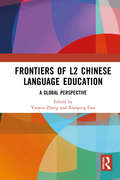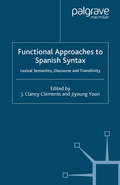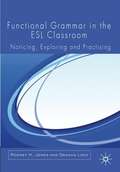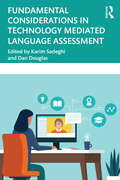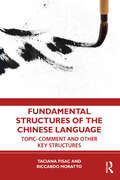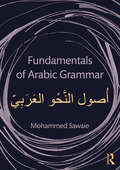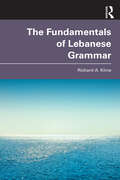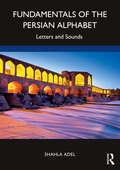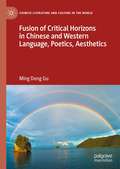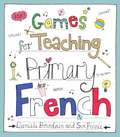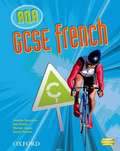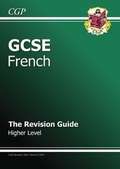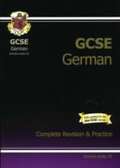- Table View
- List View
From Syntax to Discourse: Pronominal Clitics, Null Subjects and Infinitives in Child Language (Studies in Theoretical Psycholinguistics #29)
by C. Hamannclaim is that such morphological processes can be learnt without symbolization and innate knowledge. See Rumelhart and McClelland (1986) for the original model of past tense acquisition, Plunkett and Marchman (1993), Nakisa, Plunkett and Hahn (1996) and Elman et al. (1996) for developments and extensions to other morphological processes, and Marcus et al. (1992) and Pinker and Prince (1988) for criticism. One line of investigation supporting the view of language as a genetic endowment is closely linked to traditional research on language acquisition and argues as follows: If language is innate there must be phenomena that should be accessible from birth in one form or the other. Thus it is clear that the language of children, especially young children and preferably babies should be investigated. As babies unfortunately don't talk, the abilities that are available from birth must be established in ways different from the usual linguistic analysis. Psycholinguistic research of the last few years has shown that at the age of 4 and 8 months and even during their first week of life children already have important language skills. From the fourth day, infants distinguish their mother tongue from other languages. From the first months children prefer the sound of speech to 'other noise'. At the age of 4 months, infants prefer pauses at syntactic boundaries to random pauses.
Frontiers of L2 Chinese Language Education: A Global Perspective
by Yanyin ZhangOver the past four decades, learning Chinese as a second language has transformed from individual small-scale endeavors to organized mass studies worldwide. In a fast-changing world, the field of L2 Chinese language education is confronted by unprecedented challenges and opportunities. This book presents recent pedagogical practices, innovations and research in L2 Chinese language education across five continents. Bringing together a diverse range of leading researchers and educators, it showcases the latest knowledge, teaching-led research, innovative curriculum design and pedagogical practice in a variety of instructional contexts. Through a mix of overview chapters, empirical studies and critical discussions, the book addresses four key themes – formal instruction; language education technology; curriculum development; and critical overviews– and reflects the latest challenges and coping strategies for teaching and learning Chinese in an increasingly digital world. It will be essential reading for researchers, teachers and students of Chinese as a second language, as well as curriculum developers and textbook writers.
Frontiers of L2 Chinese Language Education: A Global Perspective
by Yanyin Zhang Xiaoping GaoOver the past four decades, learning Chinese as a second language has transformed from individual small-scale endeavors to organized mass studies worldwide. In a fast-changing world, the field of L2 Chinese language education is confronted by unprecedented challenges and opportunities. This book presents recent pedagogical practices, innovations and research in L2 Chinese language education across five continents. Bringing together a diverse range of leading researchers and educators, it showcases the latest knowledge, teaching-led research, innovative curriculum design and pedagogical practice in a variety of instructional contexts. Through a mix of overview chapters, empirical studies and critical discussions, the book addresses four key themes – formal instruction; language education technology; curriculum development; and critical overviews– and reflects the latest challenges and coping strategies for teaching and learning Chinese in an increasingly digital world. It will be essential reading for researchers, teachers and students of Chinese as a second language, as well as curriculum developers and textbook writers.
Function and Class in Linguistic Description: The Taxonomic Foundations of Grammar
by Mário Alberto PeriniThis book deals with the traditional problem of the classification of linguistic units, with a primary focus on word classes. The approach is descriptive rather than theoretical, and is based on the use of distinctive features analogous to the ones used in phonology, which entails a radical reworking of the traditional classification. The first part presents some basic notions such as the use of distinctive features and the role of word classes in grammar; classification by prototypes; and the use of world knowledge as a resource to assign thematic relations to constituents in the sentence. In the second part, some descriptive problems are examined, namely the classification of verbs according to valency; connectives, adverbs, and the internal constituents of the NP; and the classification of units larger than words. This book will be of use as a guide for linguists working on the description of natural languages, as well as a resource for students on courses in linguistic theory and description.
Functional Approaches to Spanish Syntax: Lexical Semantics, Discourse and Transitivity
by J. Clements J. YoonThe first usage-based approach of its kind, this volume contains twelve studies on key issues in Spanish syntax: word order, arguments, grammatical-relation marking, inalienable possession, ser and estar , adjective placement, small clauses and causatives. The studies are approached within a broad functionalist perspective. The studies strengthen the view that components of grammar intricately interact and that a usage-based approach to analyzing them offers new and insightful perspectives on some stubborn problems.
Functional Grammar in the ESL Classroom: Noticing, Exploring and Practicing (PDF)
by Graham Lock Rodney JonesA set of easy to use techniques helps students discover for themselves how grammar works in real world contexts and how grammatical choices are not just about form but about meaning. Sample teaching ideas, covering a wide range of grammatical topics including verb tense, voice, reference and the organization of texts, accompanies each procedure.
Functional Grammar in the ESL Classroom: Noticing, Exploring and Practising
by Graham Lock Rodney JonesA set of easy to use techniques helps students discover for themselves how grammar works in real world contexts and how grammatical choices are not just about form but about meaning. Sample teaching ideas, covering a wide range of grammatical topics including verb tense, voice, reference and the organization of texts, accompanies each procedure.
Fundamental Considerations in Technology Mediated Language Assessment
by Karim Sadeghi and Dan DouglasFundamental Considerations in Technology Mediated Language Assessment aims to address issues such as how the forced integration of technology into second language assessment has shaped our understanding of key traditional concepts like validity, reliability, washback, authenticity, ethics, fairness, test security, and more. Although computer assisted language testing has been around for more than two decades in the context of high-stakes proficiency testing, much of language testing worldwide has shifted to 'at home' mode, and relies heavily on the mediation of digital technology, making its widespread application in classroom settings in response to the COVID-19 outbreak as unprecedented. Integration of technology into language assessment has brought with it countless affordances and at the same time challenges, both theoretically and practically. One major theoretical consideration requiring attention is the way technology has contributed to a re-conceptualisation of major assessment concepts/constructs. There is very limited literature available on theoretical underpinnings of technology mediated language assessment. This book aims to fill this gap. This book will appeal to academic specialists, practitioners or professionals in the field of language assessment, advanced and/or graduate students, and a range of scholars or professionals in disciplines like educational technology, applied linguistics and TESOL.
Fundamental Considerations in Technology Mediated Language Assessment
by Karim Sadeghi Dan DouglasFundamental Considerations in Technology Mediated Language Assessment aims to address issues such as how the forced integration of technology into second language assessment has shaped our understanding of key traditional concepts like validity, reliability, washback, authenticity, ethics, fairness, test security, and more. Although computer assisted language testing has been around for more than two decades in the context of high-stakes proficiency testing, much of language testing worldwide has shifted to 'at home' mode, and relies heavily on the mediation of digital technology, making its widespread application in classroom settings in response to the COVID-19 outbreak as unprecedented. Integration of technology into language assessment has brought with it countless affordances and at the same time challenges, both theoretically and practically. One major theoretical consideration requiring attention is the way technology has contributed to a re-conceptualisation of major assessment concepts/constructs. There is very limited literature available on theoretical underpinnings of technology mediated language assessment. This book aims to fill this gap. This book will appeal to academic specialists, practitioners or professionals in the field of language assessment, advanced and/or graduate students, and a range of scholars or professionals in disciplines like educational technology, applied linguistics and TESOL.
Fundamental Structures of the Chinese Language: Topic-Comment and Other Key Structures
by Taciana Fisac Riccardo MorattoFundamental Structures of the Chinese Language is an exceptional resource for understanding how Chinese grammar functions in natural discourse.This book departs from the conventional approach of superimposing grammatical constructs from English onto Chinese and focuses on the topic–comment structure inherent in the Chinese language. Constructions that are usually considered complex or challenging for students whose mother tongues are subject–verb–object languages will be more easily understandable with this analysis. Simple and complex verbal structures are discussed in depth with the incorporation of the aspect category, which provides an enormous richness of nuances in the internal development of the action, and word order is considered one of the key features of the Chinese language. All the explanations are applied to numerous examples of real Chinese texts.This textbook is a valuable resource for students, teachers, and researchers in Chinese language courses including Chinese translation, Chinese linguistics, and comparison linguistics in general.
Fundamental Structures of the Chinese Language: Topic-Comment and Other Key Structures
by Taciana Fisac Riccardo MorattoFundamental Structures of the Chinese Language is an exceptional resource for understanding how Chinese grammar functions in natural discourse.This book departs from the conventional approach of superimposing grammatical constructs from English onto Chinese and focuses on the topic–comment structure inherent in the Chinese language. Constructions that are usually considered complex or challenging for students whose mother tongues are subject–verb–object languages will be more easily understandable with this analysis. Simple and complex verbal structures are discussed in depth with the incorporation of the aspect category, which provides an enormous richness of nuances in the internal development of the action, and word order is considered one of the key features of the Chinese language. All the explanations are applied to numerous examples of real Chinese texts.This textbook is a valuable resource for students, teachers, and researchers in Chinese language courses including Chinese translation, Chinese linguistics, and comparison linguistics in general.
Fundamentals of Arabic Grammar
by Mohammed SawaieFundamentals of Arabic Grammar provides an authoritative guide to Modern Standard Arabic (MSA) grammar. It has been organised to promote a thorough understanding of MSA grammar and presents its complexities in a cohesive and user-friendly format, filling many gaps left by other textbooks. Explanations are clear, full and accessible and extensive cross-referencing, two generous indices and six appendices provide users with easy access to the information they require. No prior knowledge of linguistic terminology is required. Features include: Expert treatment of a full range of grammar topics and structures, including the case system, Idhaafa, the equational sentence, quantifiers and the vocative, generously spread across thirty eight chapters Special attention to parts of speech, such as nouns, pronouns, adjectives, adverbs and propositions, given at the beginning of the book to acquaint students with the basic units of Arabic and provide a solid foundation for further learning A wide range of contemporary examples drawn from real life to provide solid context to grammar points, further supported by word glosses and idiomatic translations of sentences Grammatical terms given in both Arabic and English A wide variety of supplementary learning resources such as practice sheets, exercises and verb tables available for free download at http://www.routledge.com/books/details/9780415710046/ Substantial bibliography incorporating primary Arabic grammar sources in addition to secondary sources in Arabic and in English Fundamentals of Arabic Grammar has been field tested over a number of years and has been written by a highly experienced teacher of Arabic. It will be an essential resource for students and teachers of Arabic at all university levels and is suitable for use both as a companion reference text in Arabic language courses and as a standalone text in independent grammar classes.
Fundamentals of Arabic Grammar
by Mohammed SawaieFundamentals of Arabic Grammar provides an authoritative guide to Modern Standard Arabic (MSA) grammar. It has been organised to promote a thorough understanding of MSA grammar and presents its complexities in a cohesive and user-friendly format, filling many gaps left by other textbooks. Explanations are clear, full and accessible and extensive cross-referencing, two generous indices and six appendices provide users with easy access to the information they require. No prior knowledge of linguistic terminology is required. Features include: Expert treatment of a full range of grammar topics and structures, including the case system, Idhaafa, the equational sentence, quantifiers and the vocative, generously spread across thirty eight chapters Special attention to parts of speech, such as nouns, pronouns, adjectives, adverbs and propositions, given at the beginning of the book to acquaint students with the basic units of Arabic and provide a solid foundation for further learning A wide range of contemporary examples drawn from real life to provide solid context to grammar points, further supported by word glosses and idiomatic translations of sentences Grammatical terms given in both Arabic and English A wide variety of supplementary learning resources such as practice sheets, exercises and verb tables available for free download at http://www.routledge.com/books/details/9780415710046/ Substantial bibliography incorporating primary Arabic grammar sources in addition to secondary sources in Arabic and in English Fundamentals of Arabic Grammar has been field tested over a number of years and has been written by a highly experienced teacher of Arabic. It will be an essential resource for students and teachers of Arabic at all university levels and is suitable for use both as a companion reference text in Arabic language courses and as a standalone text in independent grammar classes.
The Fundamentals of Lebanese Grammar
by Richard A. KlineThe Fundamentals of Lebanese Grammar provides a comprehensive guide to the grammar of the spoken language of Lebanon. It presents the fundamentals and complexities of the Lebanese variety of Arabic in a practical and organized way. This guide also utilizes side-by-side transliterations in both the Arabic script and the Latin alphabet in the way that they are used by native speakers. The explanations of the grammar concepts are presented in English and are made to be easily understandable for everyone, regardless of prior linguistic knowledge. Special features of this text include endnotes on culture, expressions, and an entire chapter dedicated to regional varieties of Lebanese. This book is an essential tool for all learners of the Lebanese variety of Arabic, and it is a useful resource for every stage of the language learning process, from beginner to advanced.
The Fundamentals of Lebanese Grammar
by Richard A. KlineThe Fundamentals of Lebanese Grammar provides a comprehensive guide to the grammar of the spoken language of Lebanon. It presents the fundamentals and complexities of the Lebanese variety of Arabic in a practical and organized way. This guide also utilizes side-by-side transliterations in both the Arabic script and the Latin alphabet in the way that they are used by native speakers. The explanations of the grammar concepts are presented in English and are made to be easily understandable for everyone, regardless of prior linguistic knowledge. Special features of this text include endnotes on culture, expressions, and an entire chapter dedicated to regional varieties of Lebanese. This book is an essential tool for all learners of the Lebanese variety of Arabic, and it is a useful resource for every stage of the language learning process, from beginner to advanced.
Fundamentals of the Persian Alphabet: Letters and Sounds
by Shahla AdelFundamentals of the Persian Alphabet introduces complete beginners to the letters and sounds of Persian through pronunciation, basic vocabulary and phrases, conversation, and Persian culture. Students are also introduced to the distinction between the formal and informal forms of the language. As knowledge of letter–sound correspondence and phonological awareness is key to language learning, this textbook ensures learners start their learning journey with a strong foundation. This book is divided into six lessons presenting the modern Persian alphabet in groups of mostly similarly shaped letters that will allow learners to begin blending letters and segmenting words as soon as possible to make learning easier. With the guidance of additional audio and video resources, a comprehensive Persian–English glossary, and listening, speaking, reading, and writing exercises throughout the book, students will acquire the fundamental skills and knowledge for furthering their learning of the language. The ideal starting point for beginners, Fundamentals of the Persian Alphabet is designed for learners with very little or no previous knowledge of the language and is suitable for both independent and class-based study.
Fundamentals of the Persian Alphabet: Letters and Sounds
by Shahla AdelFundamentals of the Persian Alphabet introduces complete beginners to the letters and sounds of Persian through pronunciation, basic vocabulary and phrases, conversation, and Persian culture. Students are also introduced to the distinction between the formal and informal forms of the language. As knowledge of letter–sound correspondence and phonological awareness is key to language learning, this textbook ensures learners start their learning journey with a strong foundation. This book is divided into six lessons presenting the modern Persian alphabet in groups of mostly similarly shaped letters that will allow learners to begin blending letters and segmenting words as soon as possible to make learning easier. With the guidance of additional audio and video resources, a comprehensive Persian–English glossary, and listening, speaking, reading, and writing exercises throughout the book, students will acquire the fundamental skills and knowledge for furthering their learning of the language. The ideal starting point for beginners, Fundamentals of the Persian Alphabet is designed for learners with very little or no previous knowledge of the language and is suitable for both independent and class-based study.
Fusion of Critical Horizons in Chinese and Western Language, Poetics, Aesthetics (Chinese Literature and Culture in the World)
by Ming Dong GuThis book begins with a reflection on dichotomies in comparative studies of Chinese and Western literature and aesthetics. Critiquing an oppositional paradigm, Ming Dong Gu argues that despite linguistic and cultural differences, the two traditions share much common ground in critical theory, aesthetic thought, metaphysical conception, and reasoning. Focusing on issues of language, writing, and linguistics; metaphor, metonymy, and poetics; mimesis and representation; and lyricism, expressionism, creativity, and aesthetics, Gu demonstrates that though ways of conception and modes of expression may differ, the two traditions have cultivated similar aesthetic feelings and critical ideas capable of fusing critical and aesthetic horizons. With a two-way dialogue, this book covers a broad spectrum of critical discourses and uncovers fascinating connections among a wide range of thinkers, theorists, scholars, and aestheticians, thereby making a significant contribution to bridging the aesthetic divide and envisioning world theory and global aesthetics.
The Future of English in Asia: Perspectives on language and literature (Routledge Studies in World Englishes)
by Michael O’Sullivan David Huddart Carmen LeeThis collection is unique in bringing together key thinkers on language and literature to discuss the future of English in Asia. Many of the contributors are themselves responsible for important sub-genres in English linguistics and literary studies and this collection gives them the opportunity to respond to each other directly. The different chapters also respond to different contemporary debates and emerging trends and discourses that are hugely important for the future of English language teaching in schools across Asia. This volume is also ground-breaking in bringing English literary studies and Applied English Linguistics together in the contemporary Asian context. The Future of English in Asia includes studies on the following subject areas: Cultural Translation in World Englishes, Multilingual Education, English Futures and the function of Literature, English Literary Studies in Japan, and English and Social Media in Asia. Well into this century, it appears that it is still very difficult to know what to expect when it comes to the future of English. The future of English will continue to be determined by complex local contexts. As it has in other parts of the world, the future of English in Asia will continue to rely on the proliferation of its transformations as much as its hegemonic status. This volume reflects the widespread acknowledgement that whatever future English has will inevitably be shaped by its fate in Asia. The collection will be a welcome resource for scholars and students of English linguistics, English literary studies, and topics related to the teaching of English in Asia.
The Future of English in Asia: Perspectives on language and literature (Routledge Studies in World Englishes)
by Michael O'Sullivan David Huddart Carmen LeeThis collection is unique in bringing together key thinkers on language and literature to discuss the future of English in Asia. Many of the contributors are themselves responsible for important sub-genres in English linguistics and literary studies and this collection gives them the opportunity to respond to each other directly. The different chapters also respond to different contemporary debates and emerging trends and discourses that are hugely important for the future of English language teaching in schools across Asia. This volume is also ground-breaking in bringing English literary studies and Applied English Linguistics together in the contemporary Asian context. The Future of English in Asia includes studies on the following subject areas: Cultural Translation in World Englishes, Multilingual Education, English Futures and the function of Literature, English Literary Studies in Japan, and English and Social Media in Asia. Well into this century, it appears that it is still very difficult to know what to expect when it comes to the future of English. The future of English will continue to be determined by complex local contexts. As it has in other parts of the world, the future of English in Asia will continue to rely on the proliferation of its transformations as much as its hegemonic status. This volume reflects the widespread acknowledgement that whatever future English has will inevitably be shaped by its fate in Asia. The collection will be a welcome resource for scholars and students of English linguistics, English literary studies, and topics related to the teaching of English in Asia.
Gaeilge i Mo Chroí - Irish In My Heart: Your Guide to Loving and Living the Irish Language
by Molly Nic CéileHow do you feel about embracing Ireland's native tongue? At odds after a tricky relationship at school? Maybeyou've given up, or don't know where to start?Well, is fada an bóthar nach mbíonn casadh ann - long is the road that has no turn and, in this book, the road is about to turn.Molly Nic Céile - creator of social media sensation for Irish-language learners and lovers Gaeilge i Mo Chroí - invites us to connect with Irish in our hearts, as we set out on a journey of renewed pride sa Ghaeilge. Using seanfhocail agus scéalta, proverbs and stories, and with plenty of craic along the way - including the hilarious 'if Irish were English' approach to better understanding sentence structure - the book offers guidance on bringing Irish into our everyday lives, supported by useful word and phrase glossaries throughout.Connect with an Ghaeilge you didn't know you knew, embrace na botúin - the mistakes - and discover the richness that our beautiful language - ár dteanga álainn - has to offer.
Games for Teaching Primary French
by Danièle Bourdais Sue FinnieGames for Teaching Primary French by Danièle Bourdais and Sue Finnie is a practical toolkit containing a wide variety of fun and engaging games for all abilities, from complete beginners to more competent learners. It includes a wide range of games, from 5-minute starters or plenaries to longer, more challenging games where learners can make substantial progress. It has been devised specifically for busy teachers with limited resources, budget and planning time, who want simple and effective ideas to use in the classroom. The games in this book cover all core aspects of the primary French curriculum and are organised into the key skills areas of listening, speaking, reading and writing, with additional parts on grammar, number games and sounds. These games allow learners to absorb and explore language in a variety of mediums, building up skills, knowledge and confidence in the process. The book is packed with techniques and games to support existing schemes of work and offers plenty of inspiration and ideas for teaching primary French. The straightforward, reliable, no-tech suggestions are based on sound pedagogy and years of classroom experience, and will help deliver great learning outcomes lesson after lesson. Teaching modern foreign languages can be challenging, and can be a daunting prospect for teachers who are not language experts themselves. Games for teaching primary French is designed to support teachers with easy to follow, ready to use ideas. These flexible games can be adapted to suit any topic and any ability level. For more experienced French teachers, there are plenty of new, imaginative and fun ideas to refresh your practice. The book is perfect for Key Stage 2 teachers who want ideas for teaching French and don’t have unlimited resources and planning time.
Gcse French For Aqa Students' Book
by Daniele BourdaisAQA GCSE French helps you deliver the specification with motivating material and thorough skills and grammar preparation. This Student Book features relevant topics that students can really relate to, and provides second to none exam practice and preparation.
GCSE French Revision Guide - Higher (PDF)
by Cgp BooksThis book is full of clear revision notes, key phrases, topic vocab and useful grammar for Higher level GCSE French students - it's packed with everything you need to know for your exam. To help you remember all the important bits, there's a revision summary at the end of each section and there's a comprehensive list of essential vocab listed at the back. It's easy to read and revise from - everything's explained simply, in CGP's chatty straightforward style with the odd joke thrown in to help break up the revision.
GCSE German Complete Revision and Practice (PDF)
by Richard ParsonsThis all-in-one study resource for GCSE German covers all the grammar and vocabulary students need, split up into conveniently sized mini-topics. It also contains a range of exam-style reading, writing and speaking exercises.

